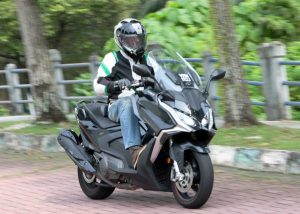VOLVO Cars Malaysia’s recent Safety Driving Experience gave fresh perspective to participants on the safety features packed in the cars from the Scandinavian brand.
Held at the KL Base in Sungai Besi – the country’s first airstrip, the event which which is part of Volvo’s For Life campaign, welcomed 240 participants consisting of owners and fans of the brand who were treated to an experience within a series of Volvo models.
This included the sports utility vehicles (SUVs) of the full-sized XC90, mid-sized XC60 and the compact XC40 currently available in either a full-electric or mild-hybrid powertrain.
Also included were the S90 luxury sedan, the S60 executive sedan and the Volvo V60 estate.
As a treat, participants had the opportunity to helm the recently-updated C40 Recharge Pure Electric crossover SUV, offered in a newly included Vapour Grey colour option.

The all-wheel-driven electric vehicle (EV), with its newly included pixel headlight technology, maintains its price at RM288,888 (on-the-road without insurance) and has up to 550km (WLTP) of range now – up from an initial 450km range.
This is thanks to the larger 82kW (from 78kWh) lithium-ion battery pack that can take up to 200kW of DC fast charging.
Participants were given the all-important safety briefing before being briefed on how to be properly seated for maximum safety and performance.
Having an ideal seating position adds a great amount of safety to the mix with too many people seated too high, low, far or close that it hampers reaction times and proper operation of the vehicle.

While everyone was born with differing proportions and may have their preferred driving position (or at least an idea of one), it isn’t usually correct.
Regardless of one’s proportions, drivers should not be seated too high to see too much of the hood, nor too low that they see more sky than the road.
Rather, the view should be centred between the top and bottom of the windshield and to achieve this, start from the bottom and work upwards.
Following this, ideal brake pedal reach is attained when the seat is adjusted forward enough so that maximum pressure can be applied before locking the knees when straightening the leg.

Being too far from the brake pedal will not allow you to provide the maximum amount of stopping power within the shortest time.
This way, in case of a severe accident, the force of the impact won’t travel through the knee to the hip and potentially shatter it – or both, leading to a costly and painful experience that will require a long recovery period.
Next, adjust the tilt and telescopic abilities of the steering wheel so that the wrist can reach the top of the wheel without allowing the back to lift from the seat’s backrest.
Finally, maintain hand placement at the three and nine o’clock positions so that the steering wheel can be turned 180 degrees in either direction.

Having the proper amount of reach will allow the driver to more effectively avoid obstacles.
With the ideal driving position being attained, participants were allowed to experience Volvo’s selection of vehicles in differing situations.
The activities would provide drivers with an insight into how to effectively deal with emergencies from obstacle avoidance, full brake-force application and trail braking to a stop (braking and swerving at the same time before coming to a full stop).
Additionally, participants were treated to a demonstration of Volvo’s rear cross-traffic alert system and adaptive cruise control before taking the vehicles through a slalom course and allowed to race down the 1.8km airstrip to end the day.

For more information on Volvo Cars Malaysia’s upcoming events, news and launches, log on to www.volvocars.com/my or follow Volvo Car Malaysia on Facebook: www.facebook.com/volvocarmalaysia/ and Instagram: www.instagram.com/volvocarmalaysia.












